2022年中考英语二轮专题:反意疑问句课件(共有PPT18张)
文档属性
| 名称 | 2022年中考英语二轮专题:反意疑问句课件(共有PPT18张) |  | |
| 格式 | zip | ||
| 文件大小 | 98.3KB | ||
| 资源类型 | 教案 | ||
| 版本资源 | 人教新目标(Go for it)版 | ||
| 科目 | 英语 | ||
| 更新时间 | 2022-02-14 22:01:35 | ||
图片预览

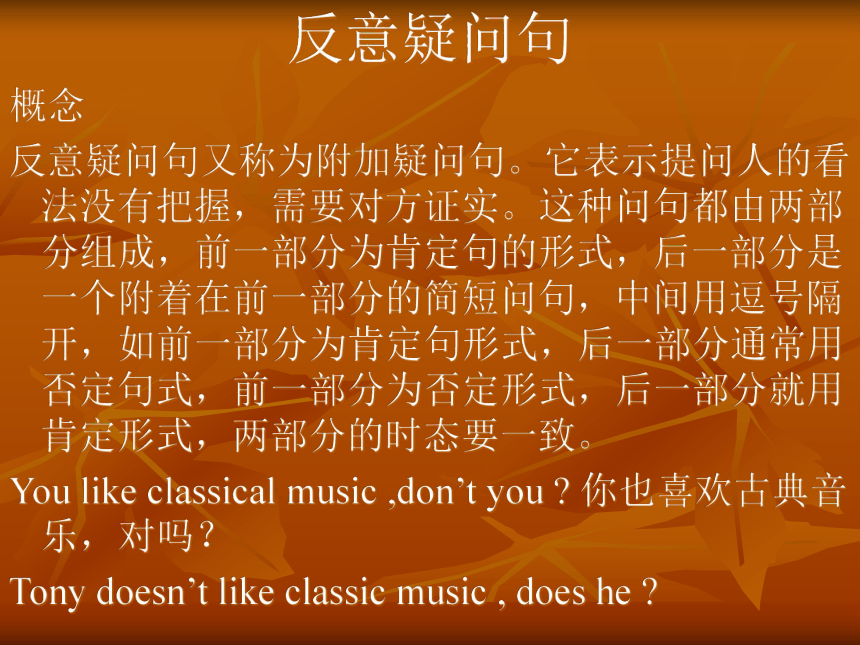
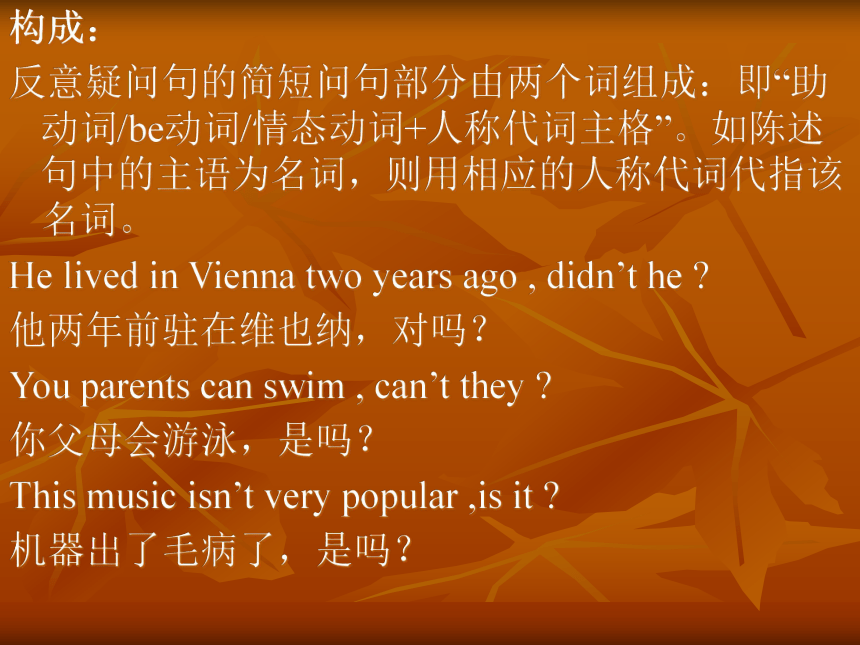
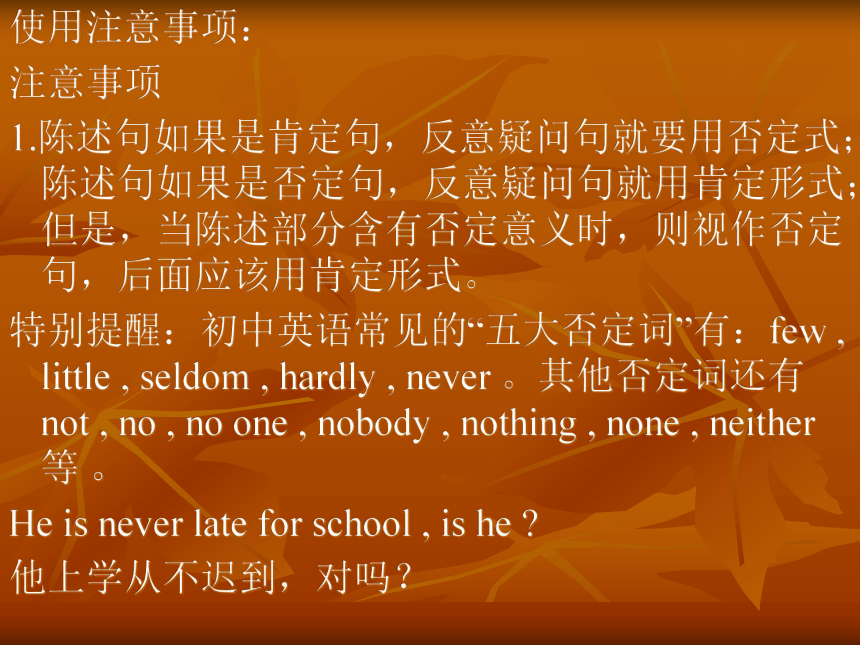
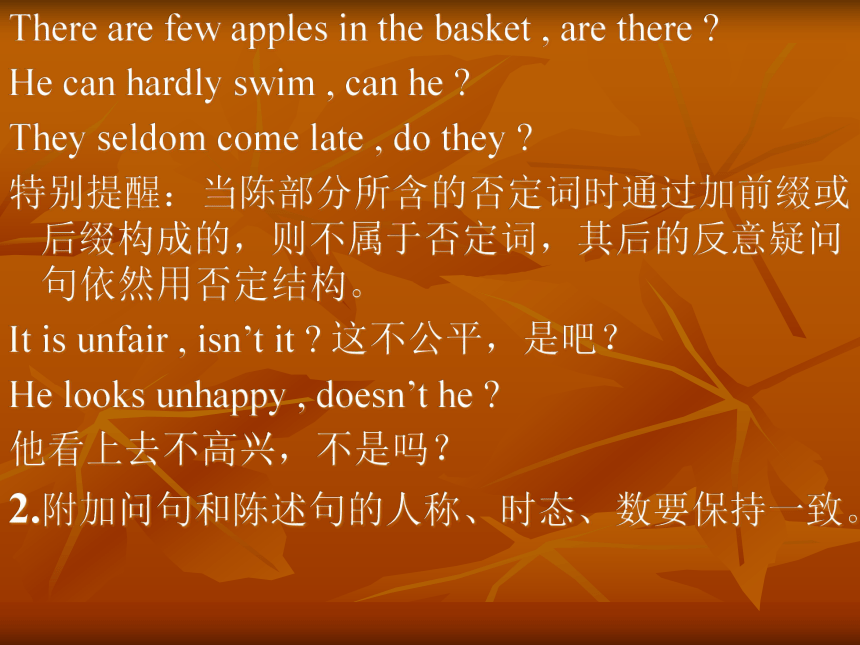
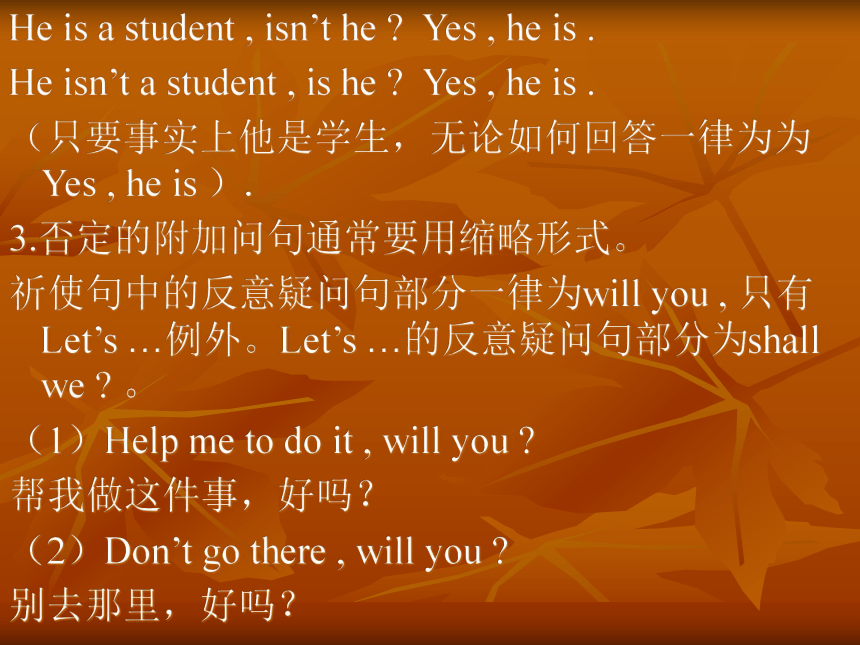
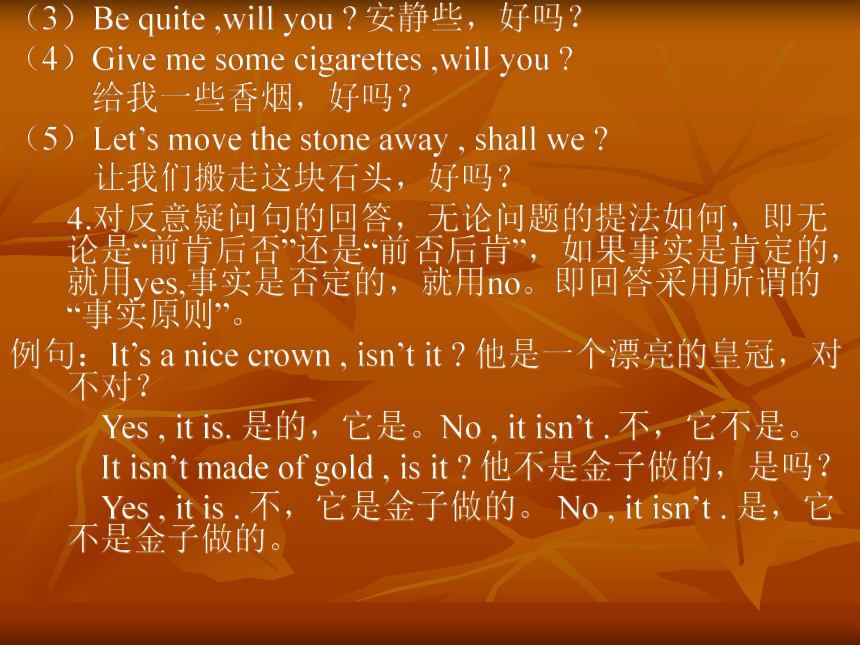
文档简介
(共18张PPT)
Question tags
反意疑问句
反意疑问句
概念
反意疑问句又称为附加疑问句。它表示提问人的看法没有把握,需要对方证实。这种问句都由两部分组成,前一部分为肯定句的形式,后一部分是一个附着在前一部分的简短问句,中间用逗号隔开,如前一部分为肯定句形式,后一部分通常用否定句式,前一部分为否定形式,后一部分就用肯定形式,两部分的时态要一致。
You like classical music ,don’t you 你也喜欢古典音乐,对吗?
Tony doesn’t like classic music , does he
构成:
反意疑问句的简短问句部分由两个词组成:即“助动词/be动词/情态动词+人称代词主格”。如陈述句中的主语为名词,则用相应的人称代词代指该名词。
He lived in Vienna two years ago , didn’t he
他两年前驻在维也纳,对吗?
You parents can swim , can’t they
你父母会游泳,是吗?
This music isn’t very popular ,is it
机器出了毛病了,是吗?
使用注意事项:
注意事项
1.陈述句如果是肯定句,反意疑问句就要用否定式;陈述句如果是否定句,反意疑问句就用肯定形式;但是,当陈述部分含有否定意义时,则视作否定句,后面应该用肯定形式。
特别提醒:初中英语常见的“五大否定词”有:few , little , seldom , hardly , never 。其他否定词还有not , no , no one , nobody , nothing , none , neither 等 。
He is never late for school , is he
他上学从不迟到,对吗?
There are few apples in the basket , are there
He can hardly swim , can he
They seldom come late , do they
特别提醒:当陈部分所含的否定词时通过加前缀或后缀构成的,则不属于否定词,其后的反意疑问句依然用否定结构。
It is unfair , isn’t it 这不公平,是吧?
He looks unhappy , doesn’t he
他看上去不高兴,不是吗?
2.附加问句和陈述句的人称、时态、数要保持一致。
He is a student , isn’t he Yes , he is .
He isn’t a student , is he Yes , he is .
(只要事实上他是学生,无论如何回答一律为为Yes , he is ).
3.否定的附加问句通常要用缩略形式。
祈使句中的反意疑问句部分一律为will you , 只有Let’s …例外。Let’s …的反意疑问句部分为shall we 。
(1)Help me to do it , will you
帮我做这件事,好吗?
(2)Don’t go there , will you
别去那里,好吗?
(3)Be quite ,will you 安静些,好吗?
(4)Give me some cigarettes ,will you
给我一些香烟,好吗?
(5)Let’s move the stone away , shall we
让我们搬走这块石头,好吗?
4.对反意疑问句的回答,无论问题的提法如何,即无论是“前肯后否”还是“前否后肯”,如果事实是肯定的,就用yes,事实是否定的,就用no。即回答采用所谓的“事实原则”。
例句:It’s a nice crown , isn’t it 他是一个漂亮的皇冠,对不对?
Yes , it is. 是的,它是。No , it isn’t . 不,它不是。
It isn’t made of gold , is it 他不是金子做的,是吗?
Yes , it is . 不,它是金子做的。 No , it isn’t . 是,它不是金子做的。
五:祈使句中可用will you 告诉或要求别人做某事。如:please open the window , will you
Don’t make any noise , will you
在Let’s …后面用shall we 如:Let’s go home together , shall we
陈述句和附加问句用逗号隔开。
陈述句为I am …时,附加问句用aren’t I 如:
I am a very honest man , aren’t
陈述句的主语为不定代词something /anything /nothing /everything 时,附加问句的主语用it 。
如:Everything is ready , isn’t it
陈述句的主语为不定代词:somebody /someone,
anybody /anyone , nobody/ no one , everybody / every one 时,附加问句的主语用he 或 they 。
如:everyone has done their best in the game , haven’t they
陈述句为There be 句型时,附加问句用“be动词+there?” 。
如:There are two cakes on the plate , aren’t there
相关练习:
A.写出下列句子的反意疑问句形式:
1.There are some apples in the basket , _____
2.The works work hard , ____________
4.The girl dislike history , __________
5.Let’s go out for a walk , __________
5.There isn’t any milk left , _________
6.Jim wants to go to there , _________
7. The book is new , _______
8. These boys have never been to Beijing ,———— ?
9. Your parents can swim , _________
10. Don’t forget it , ________
B. 翻译句子
1.让我们去买东西,好吗?
2.史密斯先生不是美国人,对吧?
不对,他是美国人。
3.他上学从不迟到,是吗?
4.他需要帮助,是吗?
5.他几乎不会游泳,对吗?
6. 听起来真有趣,是吗?
7. 他看上去不高兴,不是吗?
8. 这音乐并非十分流行,对吗?
9. 那位女士明天将去上海,不是吗?
考试汇编
Don’t forget to put the book back on the shelf , _____
do you B. don’t you C. will you D. won’t you
2. Eric’s never seen a three-D movie at the cinema, ________
A. hasn’t he B. has he C. isn’t he D. is he
3. He’s already back to Australia , _____
______ . He is on a visit to Shanghai .
isn’t he ; No B. hasn’t he; Yes
C. isn’t he ; Yes D. hasn’t he ; No
Sentence types
There are four types of sentence .They are Statements 、Questions 、Imperatives 、Exclamations.
陈述句用来说明事实、看法,描述动作、状态,阐明道理原因等。有肯定形式和否定形式两种。
陈述句
肯定式:Tim is an American boy./My uncle lives in England .
否定句:Tim isn’t an English boy ./ My uncle lives in England .
一般疑问句:
1. “be动词+主语+其他成分”
如:Is Tim an American boy .
2. “助动词+主语+动词+其他成分”
如:Does you uncle live in England
特殊疑问句:
1.“疑问代词(表语)+系动词+主语”
如:Who is the boy in green
2. “疑问代词(表语)+动词+其他成分?”
如:Who teachers you English
3.“疑问代词(宾语)+助动词+主语+动词?
如:What do you usually have lunch
4. “疑问副词+助动词+主语+动词?”
如:Where does she usually have lunch
选择疑问句:
1.“一般疑问句+A或B ?”
如:Do you want to have some coffee or milk
2. “特殊疑问句+A或B”
如:Who gets up earlier , you father or you mother .
祈使句
含有第二人称主语代词的祈使句:
1.“实义动词+宾语+(其他成分)。/! ”
如:Answer it in English .
2.“系动词+表语/!”如:Be quite !
含第一、三人称的祈使句:
“Let’+人称代词宾语或名词+动词原形+其他成分/!
如:Let me help you .
祈使句的否定形式:
1.含第二人称主语的祈使句在动词原形前加Don’t ,如:Don’t answer it in Chinese !/Don’t be late for class .
2.含第一、三人称的结构。:
第一人称:Let me /us + not +do sth .
如:Let me not go there alone .
第三人称:Don’t let sb. do sth .
如:Don’t let the baby cry .
感叹句
由what 引导的感叹句。
1.“What +a (an)+形容词+可数名词单数(+代词+谓语)! ”
如:What a nice bike (it is )!
2. “What +形容词+不可数名词(+代词+谓语)”
如:What useful in information (it is) !
3. “What+形容词+可数名词复数(+代词+谓语)!
” 如:What beautiful flower (they are )!
由How 引导的感叹句:
1.“How+形容词/副词(+主语+谓语)!”
如:How cold (it is)today.
2.“How +陈述句!”
如:How we enjoyed ourselves !
语法小练:
1.Don’t forget to lock the door when you leave the classroom , ________ _______ (完成反意疑问句)
2.They look unhappy today , _____ _____ (完成反意疑问句)
3. The new boy student has few friend here , ____ ______ (完成反意疑问句)
4. She has bought a very nice scarf .(改写为感叹句)
_______ _________ nice scarf she has bought .
5. It’s very cold today , isn’t it
______ , _________ ________ . You’d better take off your coat.(根据情景回答句子)
Question tags
反意疑问句
反意疑问句
概念
反意疑问句又称为附加疑问句。它表示提问人的看法没有把握,需要对方证实。这种问句都由两部分组成,前一部分为肯定句的形式,后一部分是一个附着在前一部分的简短问句,中间用逗号隔开,如前一部分为肯定句形式,后一部分通常用否定句式,前一部分为否定形式,后一部分就用肯定形式,两部分的时态要一致。
You like classical music ,don’t you 你也喜欢古典音乐,对吗?
Tony doesn’t like classic music , does he
构成:
反意疑问句的简短问句部分由两个词组成:即“助动词/be动词/情态动词+人称代词主格”。如陈述句中的主语为名词,则用相应的人称代词代指该名词。
He lived in Vienna two years ago , didn’t he
他两年前驻在维也纳,对吗?
You parents can swim , can’t they
你父母会游泳,是吗?
This music isn’t very popular ,is it
机器出了毛病了,是吗?
使用注意事项:
注意事项
1.陈述句如果是肯定句,反意疑问句就要用否定式;陈述句如果是否定句,反意疑问句就用肯定形式;但是,当陈述部分含有否定意义时,则视作否定句,后面应该用肯定形式。
特别提醒:初中英语常见的“五大否定词”有:few , little , seldom , hardly , never 。其他否定词还有not , no , no one , nobody , nothing , none , neither 等 。
He is never late for school , is he
他上学从不迟到,对吗?
There are few apples in the basket , are there
He can hardly swim , can he
They seldom come late , do they
特别提醒:当陈部分所含的否定词时通过加前缀或后缀构成的,则不属于否定词,其后的反意疑问句依然用否定结构。
It is unfair , isn’t it 这不公平,是吧?
He looks unhappy , doesn’t he
他看上去不高兴,不是吗?
2.附加问句和陈述句的人称、时态、数要保持一致。
He is a student , isn’t he Yes , he is .
He isn’t a student , is he Yes , he is .
(只要事实上他是学生,无论如何回答一律为为Yes , he is ).
3.否定的附加问句通常要用缩略形式。
祈使句中的反意疑问句部分一律为will you , 只有Let’s …例外。Let’s …的反意疑问句部分为shall we 。
(1)Help me to do it , will you
帮我做这件事,好吗?
(2)Don’t go there , will you
别去那里,好吗?
(3)Be quite ,will you 安静些,好吗?
(4)Give me some cigarettes ,will you
给我一些香烟,好吗?
(5)Let’s move the stone away , shall we
让我们搬走这块石头,好吗?
4.对反意疑问句的回答,无论问题的提法如何,即无论是“前肯后否”还是“前否后肯”,如果事实是肯定的,就用yes,事实是否定的,就用no。即回答采用所谓的“事实原则”。
例句:It’s a nice crown , isn’t it 他是一个漂亮的皇冠,对不对?
Yes , it is. 是的,它是。No , it isn’t . 不,它不是。
It isn’t made of gold , is it 他不是金子做的,是吗?
Yes , it is . 不,它是金子做的。 No , it isn’t . 是,它不是金子做的。
五:祈使句中可用will you 告诉或要求别人做某事。如:please open the window , will you
Don’t make any noise , will you
在Let’s …后面用shall we 如:Let’s go home together , shall we
陈述句和附加问句用逗号隔开。
陈述句为I am …时,附加问句用aren’t I 如:
I am a very honest man , aren’t
陈述句的主语为不定代词something /anything /nothing /everything 时,附加问句的主语用it 。
如:Everything is ready , isn’t it
陈述句的主语为不定代词:somebody /someone,
anybody /anyone , nobody/ no one , everybody / every one 时,附加问句的主语用he 或 they 。
如:everyone has done their best in the game , haven’t they
陈述句为There be 句型时,附加问句用“be动词+there?” 。
如:There are two cakes on the plate , aren’t there
相关练习:
A.写出下列句子的反意疑问句形式:
1.There are some apples in the basket , _____
2.The works work hard , ____________
4.The girl dislike history , __________
5.Let’s go out for a walk , __________
5.There isn’t any milk left , _________
6.Jim wants to go to there , _________
7. The book is new , _______
8. These boys have never been to Beijing ,———— ?
9. Your parents can swim , _________
10. Don’t forget it , ________
B. 翻译句子
1.让我们去买东西,好吗?
2.史密斯先生不是美国人,对吧?
不对,他是美国人。
3.他上学从不迟到,是吗?
4.他需要帮助,是吗?
5.他几乎不会游泳,对吗?
6. 听起来真有趣,是吗?
7. 他看上去不高兴,不是吗?
8. 这音乐并非十分流行,对吗?
9. 那位女士明天将去上海,不是吗?
考试汇编
Don’t forget to put the book back on the shelf , _____
do you B. don’t you C. will you D. won’t you
2. Eric’s never seen a three-D movie at the cinema, ________
A. hasn’t he B. has he C. isn’t he D. is he
3. He’s already back to Australia , _____
______ . He is on a visit to Shanghai .
isn’t he ; No B. hasn’t he; Yes
C. isn’t he ; Yes D. hasn’t he ; No
Sentence types
There are four types of sentence .They are Statements 、Questions 、Imperatives 、Exclamations.
陈述句用来说明事实、看法,描述动作、状态,阐明道理原因等。有肯定形式和否定形式两种。
陈述句
肯定式:Tim is an American boy./My uncle lives in England .
否定句:Tim isn’t an English boy ./ My uncle lives in England .
一般疑问句:
1. “be动词+主语+其他成分”
如:Is Tim an American boy .
2. “助动词+主语+动词+其他成分”
如:Does you uncle live in England
特殊疑问句:
1.“疑问代词(表语)+系动词+主语”
如:Who is the boy in green
2. “疑问代词(表语)+动词+其他成分?”
如:Who teachers you English
3.“疑问代词(宾语)+助动词+主语+动词?
如:What do you usually have lunch
4. “疑问副词+助动词+主语+动词?”
如:Where does she usually have lunch
选择疑问句:
1.“一般疑问句+A或B ?”
如:Do you want to have some coffee or milk
2. “特殊疑问句+A或B”
如:Who gets up earlier , you father or you mother .
祈使句
含有第二人称主语代词的祈使句:
1.“实义动词+宾语+(其他成分)。/! ”
如:Answer it in English .
2.“系动词+表语/!”如:Be quite !
含第一、三人称的祈使句:
“Let’+人称代词宾语或名词+动词原形+其他成分/!
如:Let me help you .
祈使句的否定形式:
1.含第二人称主语的祈使句在动词原形前加Don’t ,如:Don’t answer it in Chinese !/Don’t be late for class .
2.含第一、三人称的结构。:
第一人称:Let me /us + not +do sth .
如:Let me not go there alone .
第三人称:Don’t let sb. do sth .
如:Don’t let the baby cry .
感叹句
由what 引导的感叹句。
1.“What +a (an)+形容词+可数名词单数(+代词+谓语)! ”
如:What a nice bike (it is )!
2. “What +形容词+不可数名词(+代词+谓语)”
如:What useful in information (it is) !
3. “What+形容词+可数名词复数(+代词+谓语)!
” 如:What beautiful flower (they are )!
由How 引导的感叹句:
1.“How+形容词/副词(+主语+谓语)!”
如:How cold (it is)today.
2.“How +陈述句!”
如:How we enjoyed ourselves !
语法小练:
1.Don’t forget to lock the door when you leave the classroom , ________ _______ (完成反意疑问句)
2.They look unhappy today , _____ _____ (完成反意疑问句)
3. The new boy student has few friend here , ____ ______ (完成反意疑问句)
4. She has bought a very nice scarf .(改写为感叹句)
_______ _________ nice scarf she has bought .
5. It’s very cold today , isn’t it
______ , _________ ________ . You’d better take off your coat.(根据情景回答句子)
同课章节目录
- 词法
- 名词
- 动词和动词短语
- 动词语态
- 动词时态
- 助动词和情态动词
- 非谓语动词
- 冠词
- 代词
- 数词和量词
- 形容词副词及其比较等级
- 介词和介词短语
- 连词和感叹词
- 构词法
- 相似、相近词比较
- 句法
- 陈述句
- 一般疑问句和否定疑问句
- 特殊疑问句及选择疑问句
- 反意疑问句
- 存在句(There be句型)
- 宾语从句
- 定语从句
- 状语从句
- 主谓一致问题
- 简单句
- 并列句
- 复合句
- 主谓一致
- 主、表语从句
- 名词性从句
- 直接引语和间接引语
- 虚拟语气
- 感叹句
- 强调句
- 倒装句
- 祈使句
- 句子的成分
- 句子的分类
- 题型专区
- 单项选择部分
- 易错题
- 完形填空
- 阅读理解
- 词汇练习
- 听说训练
- 句型转换
- 补全对话
- 短文改错
- 翻译
- 书面表达
- 任务型阅读
- 语法填空
- 其他资料
